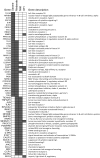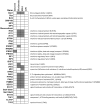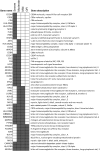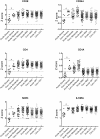Patient-based transcriptome-wide analysis identify interferon and ubiquination pathways as potential predictors of influenza A disease severity
- PMID: 25365328
- PMCID: PMC4218794
- DOI: 10.1371/journal.pone.0111640
Patient-based transcriptome-wide analysis identify interferon and ubiquination pathways as potential predictors of influenza A disease severity
Abstract
Background: The influenza A virus is an RNA virus that is responsible for seasonal epidemics worldwide with up to five million cases of severe illness and 500,000 deaths annually according to the World Health Organization estimates. The factors associated with severe diseases are not well defined, but more severe disease is more often seen among persons aged >65 years, infants, pregnant women, and individuals of any age with underlying health conditions.
Methodology/principal findings: Using gene expression microarrays, the transcriptomic profiles of influenza-infected patients with severe (N = 11), moderate (N = 40) and mild (N = 83) symptoms were compared with the febrile patients of unknown etiology (N = 73). We found that influenza-infected patients, regardless of their clinical outcomes, had a stronger induction of antiviral and cytokine responses and a stronger attenuation of NK and T cell responses in comparison with those with unknown etiology. More importantly, we found that both interferon and ubiquitination signaling were strongly attenuated in patients with the most severe outcomes in comparison with those with moderate and mild outcomes, suggesting the protective roles of these pathways in disease pathogenesis.
Conclusion/significances: The attenuation of interferon and ubiquitination pathways may associate with the clinical outcomes of influenza patients.
Conflict of interest statement
Figures





Similar articles
-
Robust Lys63-Linked Ubiquitination of RIG-I Promotes Cytokine Eruption in Early Influenza B Virus Infection.J Virol. 2016 Jun 24;90(14):6263-6275. doi: 10.1128/JVI.00549-16. Print 2016 Jul 15. J Virol. 2016. PMID: 27122586 Free PMC article.
-
Innate Immune Response to Influenza Virus at Single-Cell Resolution in Human Epithelial Cells Revealed Paracrine Induction of Interferon Lambda 1.J Virol. 2019 Sep 30;93(20):e00559-19. doi: 10.1128/JVI.00559-19. Print 2019 Oct 15. J Virol. 2019. PMID: 31375585 Free PMC article.
-
Pathway mapping of leukocyte transcriptome in influenza patients reveals distinct pathogenic mechanisms associated with progression to severe infection.BMC Med Genomics. 2020 Feb 17;13(1):28. doi: 10.1186/s12920-020-0672-7. BMC Med Genomics. 2020. PMID: 32066441 Free PMC article. Clinical Trial.
-
Web of interferon stimulated antiviral factors to control the influenza A viruses replication.Microb Pathog. 2020 Feb;139:103919. doi: 10.1016/j.micpath.2019.103919. Epub 2019 Dec 10. Microb Pathog. 2020. PMID: 31830579 Review.
-
Immunomodulatory Nonstructural Proteins of Influenza A Viruses.Trends Microbiol. 2018 Jul;26(7):624-636. doi: 10.1016/j.tim.2017.12.006. Epub 2018 Jan 17. Trends Microbiol. 2018. PMID: 29373257 Review.
Cited by
-
Development and validation of a nomogram to predict severe influenza.Immun Inflamm Dis. 2024 Sep;12(9):e70026. doi: 10.1002/iid3.70026. Immun Inflamm Dis. 2024. PMID: 39340342 Free PMC article.
-
Establishment of a Risk Score Model for Early Prediction of Severe H1N1 Influenza.Front Cell Infect Microbiol. 2022 Jan 4;11:776840. doi: 10.3389/fcimb.2021.776840. eCollection 2021. Front Cell Infect Microbiol. 2022. PMID: 35059324 Free PMC article.
-
Sputum cell IL-1 receptor expression level is a marker of airway neutrophilia and airflow obstruction in asthmatic patients.J Allergy Clin Immunol. 2018 Aug;142(2):415-423. doi: 10.1016/j.jaci.2017.09.035. Epub 2017 Dec 26. J Allergy Clin Immunol. 2018. PMID: 29103994 Free PMC article.
-
What can we learn about influenza infection and vaccination from transcriptomics?Hum Vaccin Immunother. 2019;15(11):2615-2623. doi: 10.1080/21645515.2019.1608744. Epub 2019 May 22. Hum Vaccin Immunother. 2019. PMID: 31116679 Free PMC article. Review.
-
A blood RNA transcript signature for TB exposure in household contacts.BMC Infect Dis. 2020 Jun 9;20(1):403. doi: 10.1186/s12879-020-05116-1. BMC Infect Dis. 2020. PMID: 32517725 Free PMC article.
References
-
- Harper SA, Fukuda K, Uyeki TM, Cox NJ, Bridges CB (2005) Prevention and control of influenza. Recommendations of the Advisory Committee on Immunization Practices (ACIP). MMWR Recomm Rep 54: 1–40. - PubMed
-
- Guarner J, Falcon-Escobedo R (2009) Comparison of the pathology caused by H1N1, H5N1, and H3N2 influenza viruses. Arch Med Res 40: 655–661. - PubMed
-
- To KF, Chan PK, Chan KF, Lee WK, Lam WY, et al. (2001) Pathology of fatal human infection associated with avian influenza A H5N1 virus. J Med Virol 63: 242–246. - PubMed
Publication types
MeSH terms
Substances
Grants and funding
LinkOut - more resources
Full Text Sources
Other Literature Sources
Medical
Molecular Biology Databases

